-
Back to Sri Lanka
Posted on October 11th, 2018 No comments
Waypoint is to the southwest, but RU29 is moving northeast, about 180 degrees from the waypoint. Ru29 is about 140 nautical miles south of Galle, the southern most port and the location of our recovery vessel. the red semi-circle is the 120 nautical mile circle from Galle. At 10 knots, this is a 12 hour boat ride from Galle.
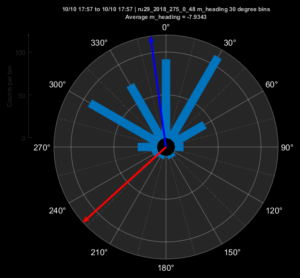
Heading compass rose. Direction to waypoint is in red, to southwest. Histogram of observed heading in 30 degree increments in light blue. Average heading is dark blue arrow, which is almost directly north, or 135 degrees to the right of the commanded heading. But we are not heading north. We are heading northeast. There must be some eastward current.
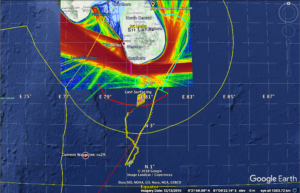
Checking traffic, the busy shipping lane extends around the southern side of Sri Lanka a distance of 40 nautical miles offshore. We don’t want to come any closer than this.
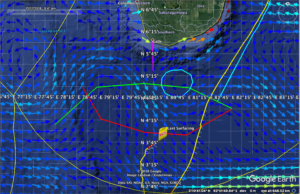
Now we zoom in and look at the currents. First Copernicus. Currents at the glider are to the southeast, so they have an eastward component. Between RU29 and Galle there is a wavy current that runs west to east. There is a low velocity region half way between Ru29 and Sri Lanka circled in cyan. The currents are counterclockwise around this low current region. So a counterclockwise eddy in Copernicus.
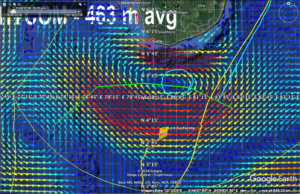
Hycom has an eddy in the exact same place as Copernicus, as seen by the cyan circle. But the circulation around the eddy in hycom is clockwise. The currents at the glider are strong and to the northwest. But the glider needs a current with an eastward component to produce the observed progress to northeast.
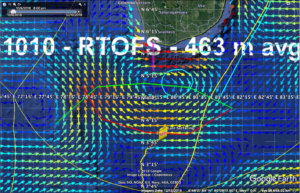
RTOFS has similar results to hycom, with a clockwise eddy between RU29 and Sri Lanka, and strong currents to northwest at the glider.
Looks like the Copernicus model wins today in this location. That means we should move the waypoint to direct our commanded heading to be more towards the south. A waypoint to the south would give us an actual glider flight direction 135 degrees to the right, or towards the northwest. Combine this with the eastward or southeastward currents, and we may get the east-west components to cancel each other, enabling us to make more progress directly to the north.
Last 5 posts by Scott Glenn
- Early Season in the Mid Atlantic - June 17th, 2021
- Disturbance in the Gulf - June 16th, 2021
- Hurricane Gliders 2021 - May 3rd, 2021
- Hurricane Iota - November 16th, 2020
- Hurricane Eta - Low Wind Shear, High SST - November 2nd, 2020



